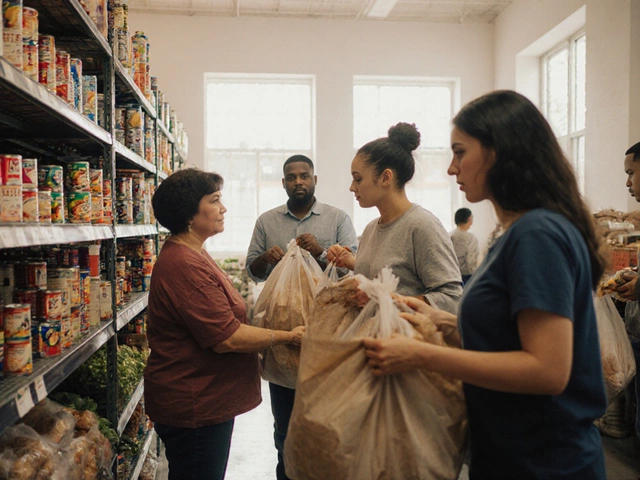Volunteer Shortage: Is It Real and What Can We Do?
Ever tried signing up to help at your kid’s school and noticed they seem a little desperate? You’re not imagining it. A lot of places—schools, charities, animal shelters—are running on fewer helpers these days. The joke about the same three parents running every bake sale has started feeling way too real.
This isn’t just local gossip. It’s happening across the country, and it’s got folks asking: are we actually running out of volunteers, or is something else at play? Spoiler—there isn’t a single answer, but it’s not just about laziness or too much Netflix. There are bigger forces at work, like busier schedules (yeah, thanks, after-school clubs), the gig economy, and just changing ideas about what “helping out” looks like.
Want the real story, and maybe a few tips to make volunteering actually fit your life? You’re in the right place. Let’s break it down and see if there’s hope for your community’s next fundraiser—or even just finding someone to coach the soccer team.
- What’s Happening With Volunteer Numbers?
- Why Are Fewer People Volunteering?
- Impact on Local Organizations
- What’s Working: Smart Ways to Attract Volunteers
- Volunteering Myths Busted
- Simple Ways to Get Involved—Today
What’s Happening With Volunteer Numbers?
So, is there really a volunteer shortage? If you ask the folks running local food banks or sports leagues, they’ll tell you there’s been a big drop in helping hands lately. The numbers back them up. In the U.S., the share of adults who said they volunteered for an organization hit a 20-year low in 2023. That’s not just a tiny blip. According to AmeriCorps and the U.S. Census Bureau, only about 23 percent of Americans officially volunteered in 2023, down from almost 28 percent in 2019.
This change isn’t just in the U.S. Australia, the UK, and parts of Europe have all reported the same dip since the pandemic. It’s not just about older volunteers retiring or people being “busier”—it’s a mix of factors that shook things up, especially during COVID-19. Lots of seniors and parents hit pause on volunteering out of safety worries or because they had kids stuck at home.
If you like seeing things laid out, here’s a quick look at U.S. volunteer rates over recent years:
| Year | Percent Volunteering |
|---|---|
| 2017 | 30.3% |
| 2019 | 28.0% |
| 2021 | 23.2% |
| 2023 | 23.0% |
One weird twist: even when official numbers are down, lots of people are still doing “informal” helping—walking a neighbor’s dog, babysitting for free, or helping someone move. This kind of help usually flies under the radar, so those acts don’t land in official volunteer trends.
Bottom line? Yes, there’s a noticeable volunteer shortage when it comes to formal opportunities. But it looks like people are still pitching in, just in new ways. Next up, I’ll dig into why those classic volunteer shifts are harder to fill—and what’s pushing people to help differently.
Why Are Fewer People Volunteering?
The drop in volunteer shortage is more than just a random blip. If you look at the numbers, there’s a clear trend—fewer Americans are signing up for unpaid gigs. For instance, the U.S. Bureau of Labor Statistics reported that the volunteer rate dropped to just around 23% in 2023 compared to almost 27% a decade ago. That’s millions fewer hands helping out every month.
The big question is: why? First up, our schedules have turned into jigsaw puzzles. Parents are managing kids’ activities, extra jobs, or side hustles. Even retirees are staying busier, sometimes working longer or caring for grandkids. After juggling work, school stuff, and family, there’s not much energy left for extra commitments.
Next, there’s the money side. As costs rise, more people pick up extra shifts or hustle online, just to keep up. Free time gets squeezed, and unpaid work can feel like a luxury.
Another reason is how people want to help looks different now. Volunteering isn't always signing up at a local nonprofit or school. People do “micro-volunteering”—quick, digital tasks—or give money instead of time. Volunteering from home is up, but many traditional groups don’t offer these options, so they miss out.
And then—trust. Some folks are frustrated by scandals or politics at big nonprofits. They worry their time might not end up helping the cause for real. This can make even would-be helpers hesitate to jump in.
Sound familiar? Here’s a cheat sheet on what’s changing:
- Longer work hours or multiple jobs = less free time
- More single-parent families means less wiggle room for volunteering
- Increased screen time and online life pull attention away from local causes
- Gen Z and Millennials value social impact, but want flexible or social media-based ways to help
If you’re wondering what this all means, it comes down to a disconnect. The old ways of finding volunteers aren’t matching modern life. If groups want more help, they’ll need to meet people where they are—online, in bursts, and with real flexibility.
| Year | Volunteer Rate (%) |
|---|---|
| 2013 | 26.8 |
| 2018 | 24.9 |
| 2023 | 23.2 |
Impact on Local Organizations
If you’ve ever seen a food bank running short on hands or a local animal shelter closed for the day, you’re seeing what a volunteer shortage really does. It’s not just about missing a bake sale; it’s about organizations having to say no to people who need help.
Here’s a number that hits hard: according to Points of Light, about 23% fewer Americans volunteered formally for an organization in 2023 compared to five years ago. That’s a drop that local nonprofits actually feel every week.
Take public libraries, for instance. At my local branch, volunteers used to run after-school programs for kids like my daughter Lydia. Now? Those programs have been cut back because there just aren’t enough folks to supervise. And it’s more than just the good feelings—fewer volunteers mean staff have to stretch further, or services just disappear.
The volunteer shortage also squeezes budgets. When people don’t step up, organizations often need to spend money hiring help or cutting what they offer. Here’s a quick look at some ways it changes the daily grind for nonprofits:
- Longer waitlists for vital services—think hot meals or job coaching.
- Canceled or scaled-down events that used to build community (and raise funds).
- Fewer outreach programs, especially for isolated groups like seniors or people with disabilities.
Check out how it stacks up with some real numbers:
| Organization Type | Pre-2020 Volunteer Hours (Avg. per Month) | 2024 Volunteer Hours (Avg. per Month) |
|---|---|---|
| Food Pantries | 1,200 | 700 |
| Animal Shelters | 950 | 540 |
| Community Libraries | 800 | 430 |
This isn’t just stressful—it’s discouraging for the staff and for those who depend on their local charities. According to The Chronicle of Philanthropy, “Volunteers are the backbone of our programs. Each missing volunteer is another person we can’t reach.”
“If we lose volunteers, we lose our ability to deliver on our mission. It’s that simple.” — Allison Bell, United Way regional director
When every hand counts, even a small dip in volunteering trends can punch a big hole in what an organization can offer. If your local charity’s been looking a bit understaffed lately, now you know why.

What’s Working: Smart Ways to Attract Volunteers
Groups scrambling for extra help aren’t just leaving sign-up sheets at the front desk anymore. They’re getting creative—and a few of these moves really do pull in more volunteers. For starters, flexible schedules matter. The old model of three hours every Wednesday night? It barely fits modern life. Now, lots of organizations are offering micro-volunteering: bite-sized projects that you can knock out in an hour or less, even from your couch.
Specific asks make a difference too. Instead of a vague “anyone want to help?” emails, the smart groups give you a clear, quick task: "Can you hand out water at the 5K Saturday morning?" or "We need two people to teach a one-hour art class next month." People jump in more when they know exactly what they're getting into.
Perks aren’t just about free pizza (though, honestly, pizza still pulls). Think about helping someone boost their resume, or offering little thank you notes from the kids helped. Real appreciation keeps people coming back. Some charities in the US are even tying volunteer hours to local discounts at coffee shops or giving certificates schools can use for student “service hours.”
Clear, easy sign-ups are key. If you make people rummage through forms or websites, most will give up. The best organizations use social media, text reminders, or apps that let people volunteer with a tap. It’s fast, it’s friendly, and it feels like less of a hassle.
Here’s a look at what’s actually helping groups fill those volunteer gaps:
- Micro-volunteering: Tasks that take under an hour, often done from home
- Targeted, clear asks: Specific jobs with defined time commitments
- Flexible scheduling: Drop-in opportunities or sign-ups by the week
- Modern tech: Using apps, texts, and simple web forms for organizing
- Partner perks: Discounts, skills badges, or community service credits
Want proof these smart moves actually work? Looks like community organizations using volunteer-matching apps saw double the sign-up rates compared to old-school bulletin boards, according to VolunteerMatch’s 2024 usage report. Half of their new volunteers said they wouldn’t have noticed opportunities without that easy tech. Bottom line: If you want volunteers, meet them where they are—in their inboxes, on their phones, and around their crazy schedules.
Volunteering Myths Busted
When it comes to talking about the volunteer shortage, a bunch of myths keep popping up. Let’s clear up some of the biggest ones with real facts and experiences, because a lot of people stay on the sidelines for reasons that just aren’t true.
Myth 1: You Need Tons of Free Time
This stops people before they even start. Some think that signing up means committing every weekend or giving up whole days. That isn’t true. Plenty of places love “micro-volunteering” — it can be as quick as an hour a week, or jumping in once for an event. Many nonprofits now offer remote or flexible volunteer spots, so you can help out even if you’re busy.
Myth 2: Only Retired Folks Volunteer
Think all volunteers are retirees with hours to spare? Not anymore. The 2023 Volunteer Trends report found the biggest jump in new volunteers was actually from people ages 25–44. Parents, college students, working adults—lots of people want to help, they just do it a little differently now (think skill-sharing or virtual options).
Myth 3: You Have to Be “Good” at Something Special
Nope. Of course, your tech skills, carpentry, or coaching can come in handy, but many groups just need willing hands and friendly faces. Food banks, blood drives, and animal rescues often need help that’s easy to learn on the spot. If you’re unsure, most places offer a quick walkthrough or simple training.
Myth 4: Volunteering Doesn’t Make a Real Difference
This one really bugs me—because it’s flat out wrong. Volunteers keep some organizations alive. In fact, according to the National Council of Nonprofits, almost 70% of small nonprofits say they couldn’t run programs without unpaid helpers. Your one hour making calls or stacking boxes isn’t small—collectively, those hours add up fast.
| Volunteer Myth | The Reality |
|---|---|
| Too time-consuming | Flexible shifts, many roles need just 1-2 hours |
| Only for older adults | Millennials and Gen Z participation is rising |
| Need special skills | Most groups offer training and welcome newcomers |
| Minor impact | Volunteers provide essential support for most causes |
Here’s the bottom line: there’s a spot for everyone, no matter your schedule or background. If you’re interested in volunteering trends or just want to see where you fit, don’t let these myths get in the way of lending a hand.
Simple Ways to Get Involved—Today
Feeling overwhelmed by the idea of becoming a regular volunteer? Most people think you have to set aside big chunks of time to make a difference, but that’s just not true. Here are real-life ways you can jump into volunteer opportunities that fit actual busy schedules—no guilt, no full-year commitments.
- Try single-day events: Look for school clean-ups, food drives, and park projects. Many groups offer one-off chances perfect for testing the waters or showing your kids how it’s done.
- Use your skills online: Tons of nonprofits need digital help. Whether you’re good at design, writing, or even fixing up websites, you can help from your couch. Platforms like Catchafire or VolunteerMatch list dozens of needs.
- Bring the family: Volunteering isn’t just for adults. Organizations like Meals on Wheels or local food banks often let kids help out, turning a Saturday morning into something meaningful for everyone. My daughter Lydia loves packing lunch bags more than any screen-time.
- Micro-volunteering: Short tasks—think translating a page, making phone calls, or social media posting—can be done in less than an hour. Sites like DoSomething.org make it super simple.
- Support virtually: If you’re working from home lately, look for remote volunteer gigs. Charities constantly need help with data entry, sending emails, or even planning events online.
Here’s a quick look at how people found their last volunteer opportunities according to the 2024 Gallup survey:
| How People Found Volunteer Work | Percent |
|---|---|
| Through friends/family | 39% |
| Online platforms | 28% |
| Workplace/group recommendation | 19% |
| Social media | 8% |
| Posters/newsletters | 6% |
The fastest way to get started? Think about what you already enjoy, then search for a local or virtual way to share that skill. Type "volunteer shortage opportunities near me" or your favorite cause into Google. You’ll be surprised—help really is needed everywhere. Even an hour helps fix the problem of too few volunteers.







